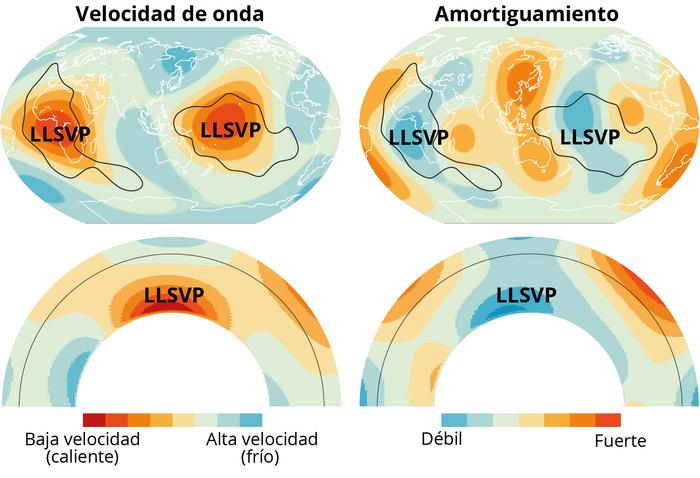Earth’s mantle behaves like a slow-moving fluid, but that hasn’t stopped two vast regions at its base from maintaining a separation from the rest. These continent-sized areas are hotter than the rest of the mantle – and according to new research, have maintained that status for at least half a billion years. The same areas could be responsible for volcanoes that occur away from plate boundaries.
ADVERTISEMENT GO AD FREE
The knowledge that heat flows from a hot location to a cold one must surely go back hundreds of thousands of years. A scientifically rigorous description dates to Newton. Yet we continue to be surprised at the way regions of heat can maintain themselves relative to surrounding conditions.
In the 1990s, seismologists discovered two hot zones within Earth’s mantle: one under most of Africa, Spain, and part of the Atlantic; the other under the Pacific Ocean. “Nobody knew what they are, and whether they are only a temporary phenomenon, or if they have been sitting there for millions or perhaps even billions of years,” said study co-author Professor Arwen Deuss of Utrecht University in a statement. The age was particularly significant – it’s one thing for temporary warm areas to arise, such as when an area exposed to the Sun remains warmer than its neighbor as dusk sets in. If that heat difference is retained long-term, there is more explaining to do.
Locations of the two LLSVPs with the continents (faintly) outlined.
Utrecht University
“These two large islands are surrounded by a graveyard of tectonic plates which have been transported there by a process called ‘subduction’, where one tectonic plate dives below another plate and sinks all the way from the Earth’s surface down to a depth of almost three thousand kilometres,” Deuss added.
The areas are known as Large Low Seismic Velocity Provinces (LLSVPs) because seismic waves slow down as they pass through, a product of vibrations produced by the higher temperatures interfering with transmission. They sit at the bottom of the mantle, where it meets the outer core.
Deuss and colleagues investigated the seismic interference LLSVPs provide. “Against our expectations, we found little damping in the LLSVPs,” first author Dr Sujania Talavera-Soza said. Even though the LLSVPs change the frequency of the waves as they pass through, the authors found, they don’t affect the volume much. This is in contrast to the surrounding cold slabs, which cause considerable damping. The results contrast with the upper mantle where, Talavera-Sozasaid said; “We found exactly what we expected: it is hot, and the waves are damped.”
The team explained the differences in transmission as a consequence of the grain size of particles within the LLSVPs, which Deuss said is “much more important” than temperature. “Subducting tectonic plates that end up in the slab graveyard consist of small grains because they recrystallize on their journey deep into the Earth. A small grain size means a larger number of grains and therefore also a larger number of boundaries between the grains.” This leads to more damping than in the large-grained LLSVPs, as energy is lost every time a wave crosses the boundary between grains.
ADVERTISEMENT GO AD FREE
If the LLSVPs grains are so large, the authors concluded, these zones must be very old, since grains grow slowly – particularly in rigid blocks like the LLSVPs. Instead of being mixed in with the rest of the mantle as textbooks say, the LLSVPs remain aloof, holding onto their heat over hundreds of millions of years. Looking at it the other way, a different chemical composition or variation in grain size would assist in maintaining long-term temperature differences.
Indeed, the LLSVPs may even be remnants of when the mantle first formed out of the magma ocean that once covered Earth. Nevertheless, the grains modeled for the LLSVPs are hardly giants, being around 1 millimeter (0.04 inches) across, which is still about ten times larger than the authors suspect for neighboring regions.
Large as the LLSVPs are, phenomena hundreds of kilometers beneath our feet mostly interests us when it affects the surface. The authors think they may be doing that, in the form of mantle plumes, where bubbles of hot material rise to the surface to produce volcanic regions, most famously Hawaii. “We think that those mantle plumes originate at the edges of the LLSVPs.” Deuss said.
Although earthquakes are common, only a few are large and deep enough to make the whole planet shake and provide the clarity needed to resolve the effects of LLSVPs, surrounding slab graveyards, and upper mantle behavior. However, with a database stretching back to 1975, the authors say that enough have been observed to interpret with confidence.
ADVERTISEMENT GO AD FREE
Coincidentally, the work is published soon after the first evidence for a similar sustained difference in temperature in the Martian mantle, which may have caused the difference in altitude between the red planet’s hemispheres.
The study is published in the journal Nature.
Source Link: Giant Ancient Hot Spot “Islands” Found In Earth’s Mantle Using Earthquake Data
